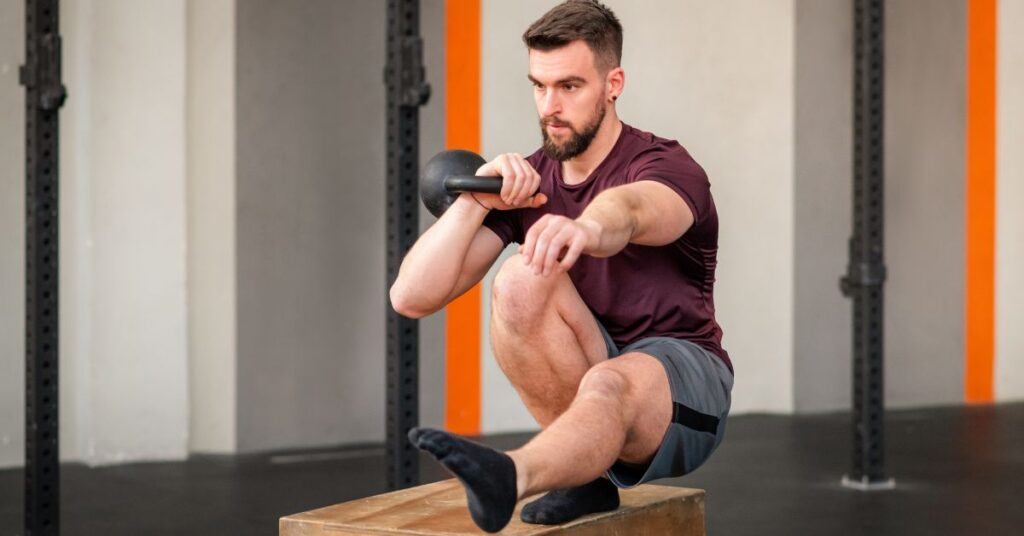Top 10 Calisthenics Exercises for Triceps: Tricep Dips for full tricep activation, Diamond Push-Ups for lateral head, Close-Grip Push-Ups for all heads, Forearm Push-Ups for advanced isolation, Wall Tricep Press for beginners, Crab Walk for triceps and core, Pike Push-Ups for shoulders and triceps, Triceps Extension Push-Ups for pure isolation, Hindu Push-Ups for dynamic movement, Single-Arm Push-Ups for expert strength.
Calisthenics for triceps development represents one of the most effective approaches to building arm strength without requiring expensive equipment. Through strategic bodyweight movements, you can achieve remarkable triceps growth while developing functional strength that translates to everyday activities. This comprehensive calisthenics for triceps approach emphasizes natural movement patterns proven effective across decades of fitness training.
Table of Contents
Top 10 Calisthenics for Triceps Exercises
Building powerful triceps requires no gym equipment when you master these effective bodyweight exercises. These ten proven calisthenics movements systematically target all three tricep heads through progressive difficulty levels, from beginner-friendly wall presses to advanced single-arm variations. Develop functional strength, muscle definition, and pressing power using only your body weight. These carefully selected calisthenics exercises target the triceps through varied angles and movement patterns for comprehensive development.
Master the proper form and technique to maximize core engagement with how to do flutter kicks.
Calisthenics for Triceps Exercise: Overview Table
| Exercise | Difficulty Level | Primary Target | Equipment Needed |
|---|---|---|---|
| Tricep Dips | Beginner-Intermediate | All tricep heads | Chair/Bench/Parallel bars |
| Diamond Push-Ups | Intermediate | Lateral head emphasis | None |
| Close-Grip Push-Ups | Beginner-Intermediate | All tricep heads | None |
| Forearm Push-Ups | Advanced | All tricep heads | None |
| Wall Tricep Press | Beginner | All tricep heads | Wall |
| Crab Walk | Intermediate | Triceps + Core | None |
| Pike Push-Ups | Intermediate-Advanced | Triceps + Shoulders | None |
| Triceps Extension Push-Ups | Advanced | Pure tricep isolation | None |
| Hindu Push-Ups | Intermediate-Advanced | Dynamic triceps | None |
| Single-Arm Push-Ups | Expert | Ultimate challenge | None |
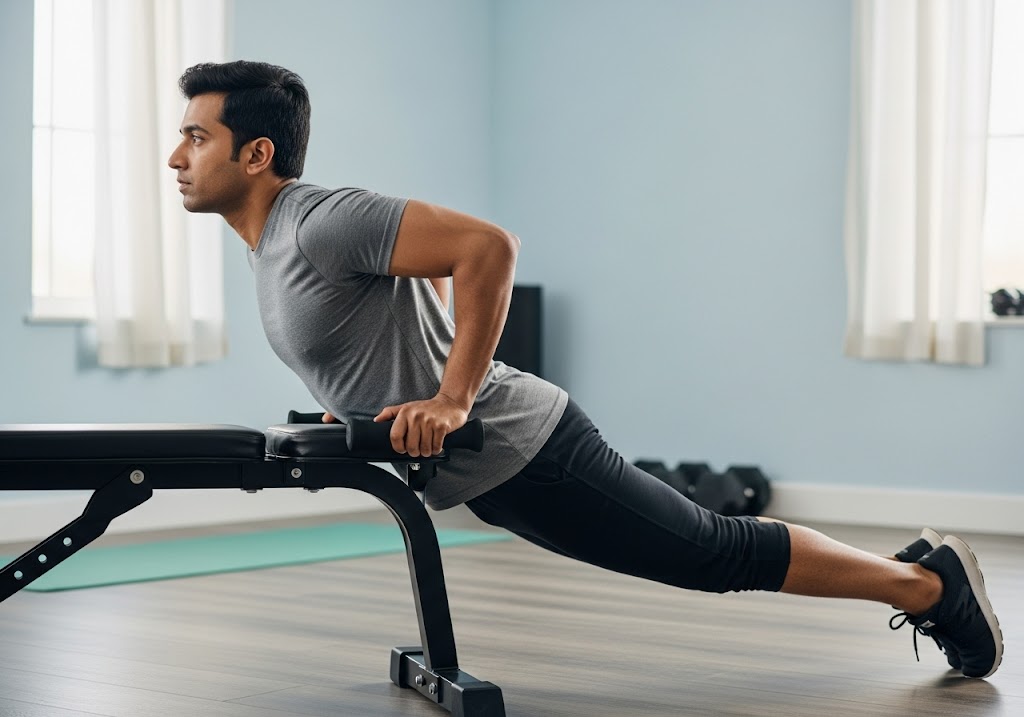
1. Tricep Dips
Tricep dips represent the cornerstone of calisthenics for triceps training. Bench dips provide an accessible starting point, while parallel bar dips increase loading. Proper form requires maintaining vertical torso positioning while lowering until shoulders drop slightly below elbow level.
How to Do Tricep Dips?
- Sit on edge of bench/chair with hands beside hips, fingers forward
- Walk feet forward, supporting body weight on hands
- Keep shoulders over wrists and core engaged
- Lower body by bending elbows straight back (not flared out)
- Descend until shoulders are slightly below elbow level
- Press through palms to return to starting position
- Keep legs straight for harder variation, bent for easier

2. Diamond Push-Ups
Diamond push-ups earn recognition as the most effective calisthenics exercise for triceps development. The diamond hand position maximizes triceps engagement while minimizing chest involvement. This exercise particularly targets the lateral head due to close-grip positioning.
How to Do Diamond Push-Ups?
- Start in standard push-up position
- Bring hands together under chest, forming diamond with thumbs and index fingers
- Keep body in straight line from head to heels
- Lower chest toward diamond hand position
- Keep elbows close to body throughout movement
- Press back up to starting position
- Focus on squeezing triceps at top of movement

3. Close-Grip Push-Ups
Close-grip push-ups modify traditional push-ups by narrowing hand spacing to shoulder-width. This adjustment shifts emphasis from chest to triceps while maintaining familiar calisthenics workout movement patterns. Hand positioning beneath shoulders with forward-pointing fingers ensures optimal activation.
How to Do Close-Grip Push-Ups?
- Begin in standard push-up position
- Place hands directly under shoulders, closer than normal width
- Point fingers forward, keep wrists straight
- Maintain straight body line throughout movement
- Lower chest while keeping elbows close to sides
- Descend until chest nearly touches hands
- Press up powerfully, focusing on tricep engagement
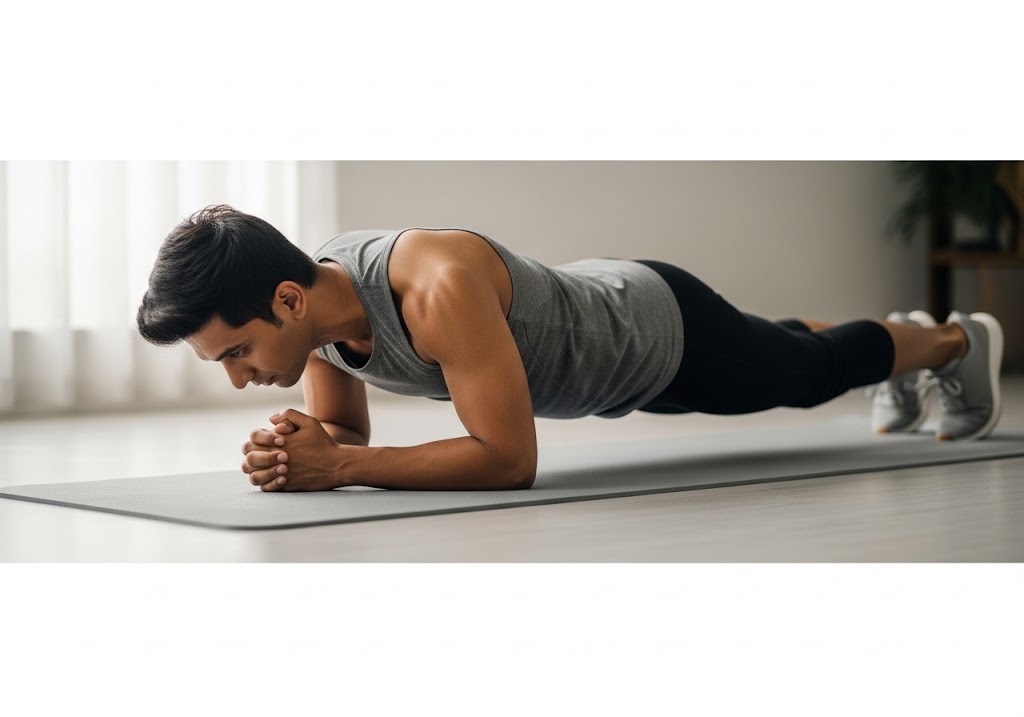
4. Forearm Push-Ups
Forearm push-ups challenge triceps through unique range of motion beginning with forearms on ground. This calisthenics exercise requires pushing from forearm position to full extension, creating intense activation throughout the movement range.
How to Do Forearm Push-Ups?
- Start in forearm plank position with forearms flat on ground
- Keep elbows directly under shoulders
- Maintain straight body line from head to heels
- Press one hand down, then the other to push up to plank
- Return to forearm position one arm at a time
- Alternate which arm leads each repetition
- Keep core tight throughout entire movement
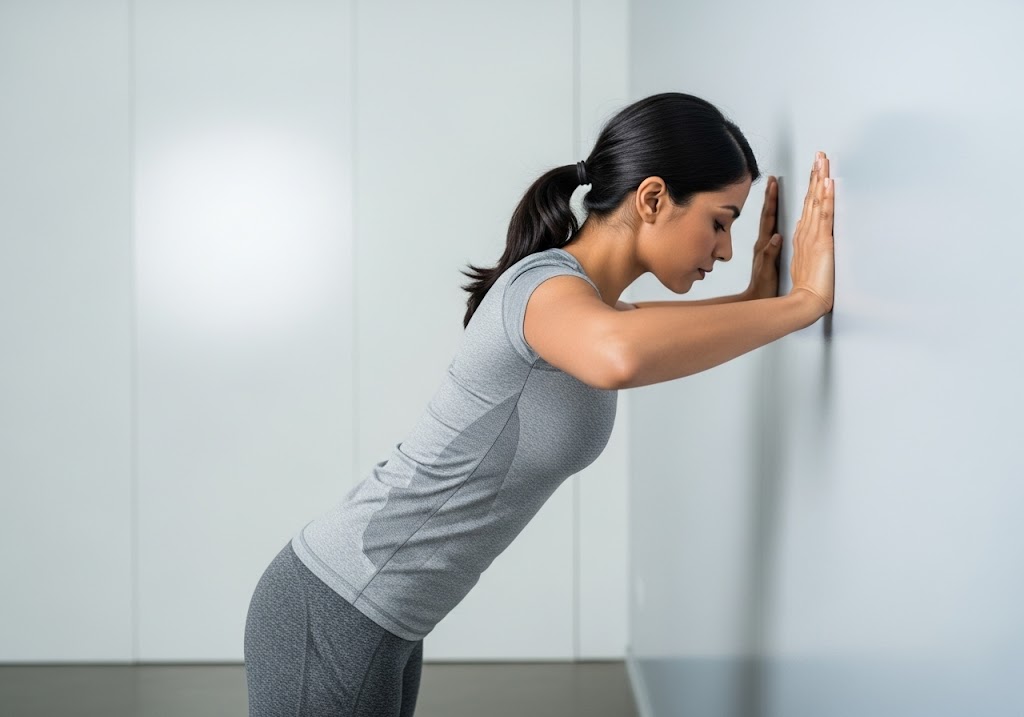
5. Wall Tricep Press
Wall tricep press serves as ideal introduction for beginners or those with limited upper body strength. The vertical position reduces body weight percentage while maintaining proper movement patterns. Progression occurs by stepping farther from the wall to increase resistance in this fundamental calisthenics exercise.
How to Do Wall Tricep Press?
- Stand arm’s length from wall
- Place palms flat against wall at shoulder height
- Keep hands closer than shoulder-width apart
- Step feet back slightly to create angle
- Lean toward wall by bending elbows
- Keep elbows close to body, pointing downward
- Push back to starting position using triceps
- Progress by stepping farther from wall
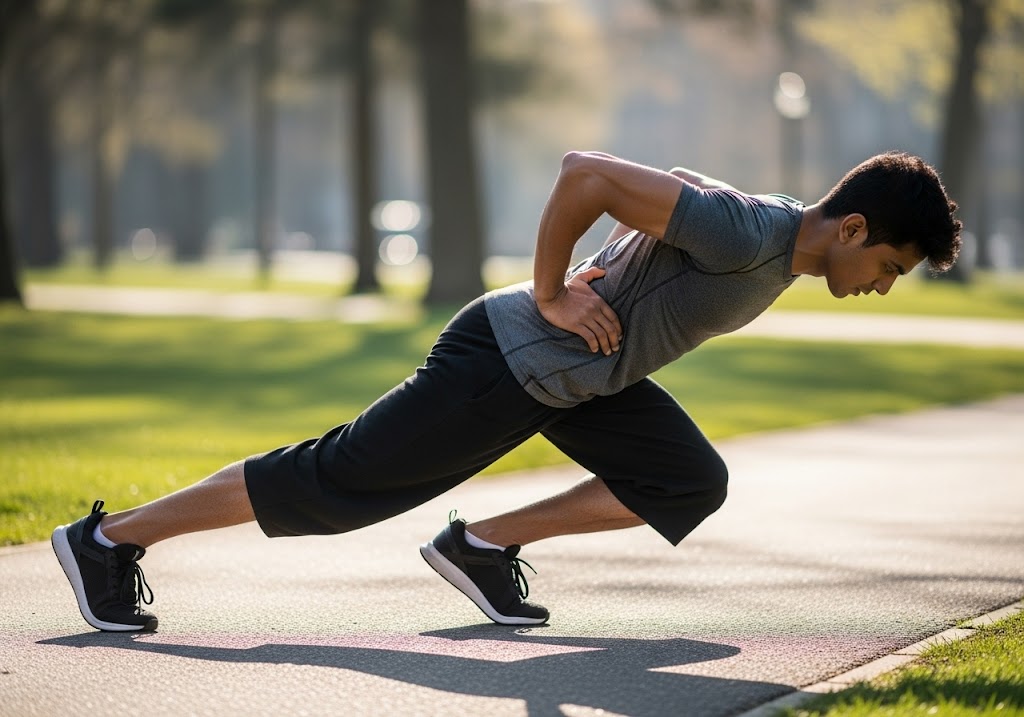
6. Crab Walk
Crab walk combines triceps strengthening with cardiovascular conditioning. This dynamic calisthenics exercise requires maintaining reverse bridge position while moving, creating sustained triceps engagement alongside core activation.
How to Do Crab Walk?
- Sit on ground with knees bent, hands behind body
- Lift hips up into reverse bridge position
- Keep fingers pointing toward feet
- Walk forward by moving opposite hand and foot
- Maintain elevated hip position throughout
- Keep core engaged and back straight
- Walk designated distance forward, then backward
- Focus on controlled movements
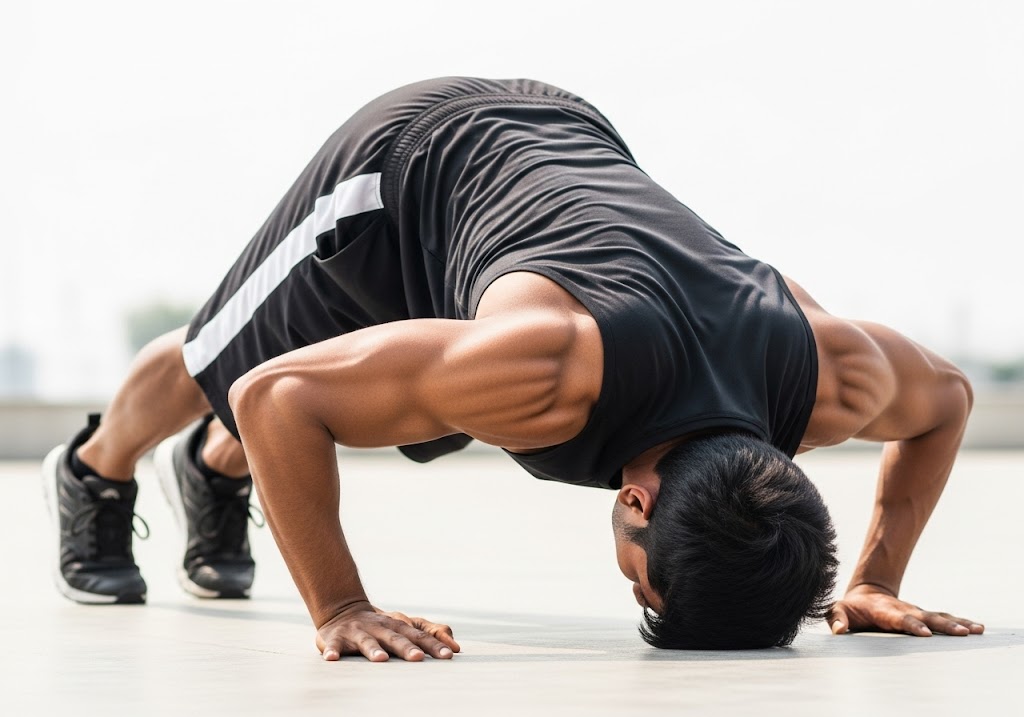
7. Pike Push-Ups
Pike push-ups target triceps while emphasizing anterior deltoids, making them excellent handstand push-up preparation. The inverted angle shifts loading vector to challenge triceps through different motion planes in this advanced calisthenics exercise.
How to Do Pike Push-Ups?
- Start in downward dog position with hands shoulder-width apart
- Walk feet closer to hands to increase pike angle
- Keep legs straight and weight on balls of feet
- Lower head toward hands by bending elbows
- Keep elbows pointing forward, not flared
- Descend until head nearly touches ground
- Press back up to starting position
- Maintain pike position throughout movement
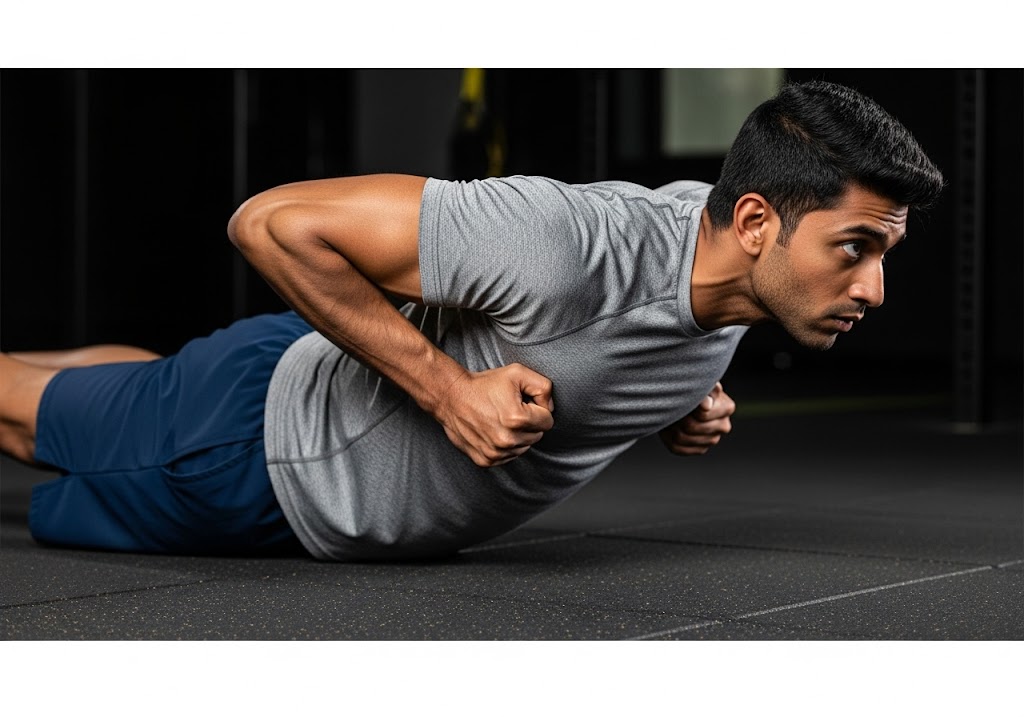
8. Triceps Extension Push-Ups
This variation isolates triceps by eliminating chest involvement through specific positioning. Upper arms remain stationary while forearms move, creating pure triceps extension movement resembling overhead extensions in prone position. This advanced calisthenics exercise targets all three triceps heads effectively.
How to Do Triceps Extension Push-Ups?
- Start in standard push-up position
- Place hands wider than shoulder-width
- Keep upper arms stationary throughout movement
- Lower by bending only at elbows, not shoulders
- Descend until forearms are parallel to ground
- Keep upper arms perpendicular to ground
- Extend only at elbows to return to start
- Focus on isolated tricep movement
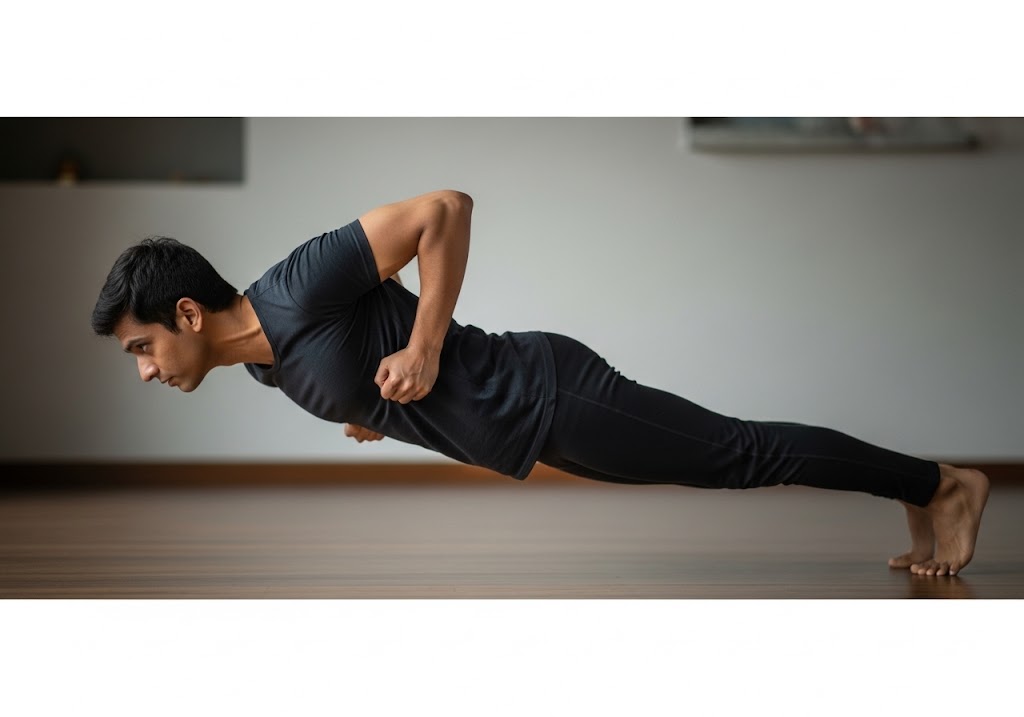
9. Hindu Push-Ups
Hindu push-ups incorporate flowing movement patterns challenging triceps through multiple angles while developing flexibility. The continuous motion improves muscular endurance while building functional strength through this traditional calisthenics exercise.
How to Do Hindu Push-Ups?
- Start in downward dog position
- Dive forward and down in swooping motion
- Lower chest and hips toward ground
- Transition through low push-up position
- Press up into upward dog position
- Reverse motion back to downward dog
- Create smooth, flowing movement pattern
- Focus on continuous motion throughout

10. Single-Arm Push-Ups (Progression)
Single-arm push-ups represent the ultimate calisthenics for triceps challenge, requiring exceptional strength and coordination. Progressive development begins with elevated surfaces, gradually decreasing height to build toward full single-arm capability.
How to Do Single-Arm Push-Ups?
- Start with elevated surface (box, bench)
- Place one hand in center of chest area
- Place other hand behind back
- Spread feet wider for more stability
- Lower chest toward supporting hand
- Keep body straight, avoid rotating
- Press back up using one arm
- Progress by lowering elevation height
- Master on ground level for full achievement
- Practice with both arms equally
Discover all the Jumping Jacks Exercise Benefits and why it’s a must-add to your routine.
Why Focus on Triceps in Your Calisthenics Workout?
Triceps development through calisthenics workout routines provides the foundation for superior upper body strength and aesthetic appeal. The triceps comprises two-thirds of your upper arm mass, making it more influential in arm size than the biceps. When you prioritize calisthenics for triceps training, you’re investing in muscles that directly impact pushing movements and overall arm definition. Strong triceps are essential for preventing shoulder impingement and maintaining healthy joint mechanics.
From a functional perspective, calisthenics for triceps strength directly correlates with your ability to perform push-ups, dips, and handstand push-ups. Athletes who focus on calisthenics for triceps development through bodyweight training often experience improved performance in sports requiring explosive pushing power. The convenience factor makes calisthenics workout programs adaptable to any environment without equipment dependencies. Mastering calisthenics for triceps creates a solid foundation for advanced bodyweight movements.
Wonder which squat variation is more effective? Compare muscle engagement and mobility demands in front squat vs back squat
Anatomy of the Triceps: Know the Muscles You’re Training
Understanding tricep anatomy enhances the effectiveness of your calisthenics exercises by enabling targeted muscle activation. The triceps brachii consists of three distinct heads that work together to extend the elbow and stabilize the shoulder. Effective calisthenics for triceps training requires understanding how each head functions, and how calisthenics workout design can target each area specifically:
- Long Head: Originates from the scapula and crosses both shoulder and elbow joints, making it highly active during overhead movements like pike push-ups and handstand progressions. This head responds well to calisthenics exercises that combine shoulder extension with elbow extension.
- Lateral Head: Positioned on the outer portion of the upper arm, this head contributes significantly to the horseshoe shape associated with well-developed triceps. Close-grip and diamond push-ups particularly emphasize lateral head activation due to hand positioning and force angles in calisthenics workout routines.
- Medial Head: Located deeper beneath the other two heads, it provides stability and endurance during extended triceps contractions. This head remains active throughout most calisthenics exercises, serving as the workhorse that maintains consistent activation patterns.
Functional anatomy knowledge becomes practical when designing calisthenics exercises routines. Exercises combining shoulder and elbow movement patterns simultaneously challenge all three triceps heads while developing coordination. This understanding explains why certain calisthenics exercises feel different and target specific areas of the triceps muscle group. Proper calisthenics for triceps programming leverages this anatomical knowledge for optimal results.
Key Benefits of Calisthenics for Triceps
Calisthenics exercises for triceps development offer unique advantages that extend beyond simple muscle building. The comprehensive benefits of calisthenics for triceps training include multiple physiological and practical advantages:
- Enhanced Muscle Strength: Gains through calisthenics workout training occur differently than traditional weight training due to constant tension and stabilization requirements. This creates comprehensive muscle development including both prime movers and stabilizing muscles throughout the entire kinetic chain.
- Superior Endurance Development: Higher repetition ranges typical in calisthenics exercises enhance muscular endurance while maintaining strength gains. This combination proves particularly valuable for athletes requiring sustained upper body performance like swimmers and rock climbers.
- Improved Joint Stability: Multi-planar movement patterns naturally strengthen supporting tissues around elbow and shoulder joints. Physical therapists frequently recommend calisthenics exercises for triceps training for injury prevention and rehabilitation due to controlled loading patterns.
- Unmatched Accessibility: Requiring no equipment makes it possible to maintain calisthenics workout consistency regardless of location, budget constraints, or time limitations. This factor alone makes calisthenics for triceps sustainable for long-term fitness goals.
- Functional Movement Integration: Calisthenics exercises improve real-world strength that translates directly to daily activities, sports performance, and other physical challenges beyond the training environment.
Complete Calisthenics Triceps Workout Routine
Strong triceps are essential for pushing movements, arm definition, and overall upper body strength. This bodyweight-focused routine targets all three tricep heads using progressive exercises that require no equipment. Perfect for building lean muscle mass and functional strength anywhere, anytime. A structured approach to calisthenics workout programming ensures consistent progress while preventing overuse injuries. Building an effective calisthenics for triceps routine requires progressive programming that challenges all strength levels:
Beginner Routine (3 sessions per week)
Week 1-4 focuses on establishing movement patterns and base strength. Include wall tricep press (3×8-12), bench dips with bent knees (3×5-8), close-grip push-ups (2×3-6), and crab walk holds (3×15-30 seconds). Rest 60-90 seconds between sets. This foundational calisthenics workout builds essential strength progressively.
Intermediate Routine (4 sessions per week)
Intermediate programming introduces challenging exercises with increased volume. Incorporate diamond push-ups (3×6-10), parallel bar dips (3×5-8), pike push-ups (2×4-8), and forearm push-ups (2×3-5). Progress through increased repetitions or advanced variations. This intermediate calisthenics workout challenges strength and endurance simultaneously.
Advanced Routine (5-6 sessions per week)
Advanced practitioners require sophisticated programming challenging strength, endurance, and skill simultaneously. Include handstand push-up progressions, single-arm work, and plyometric variations in your calisthenics workout routine. Recovery becomes crucial with attention to sleep, nutrition, and stress management. Advanced calisthenics for triceps programming demands careful attention to recovery protocols.
Learn proper form and technique in How to Do Plank Exercise and get the most out of every second.

Pro Tips to Maximize Your Triceps Gains
Implementing advanced techniques elevates basic calisthenics for triceps training to professional-level effectiveness. These calisthenics workout optimization strategies maximize your training efficiency:
Warm-up and Mobility Preparation
Proper warm-up targeting shoulders, elbows, and wrists prevents injury while optimizing performance. Dynamic routines should include arm circles, shoulder dislocations, and gentle triceps stretches. The process should require 8-10 minutes and leave you prepared rather than fatigued. Effective calisthenics workout preparation enhances performance significantly.
Progressive Overload Techniques Using Only Bodyweight
Progressive overload requires creativity since external weight cannot be added easily. Tempo manipulation offers effective strategy with slower eccentric phases increasing time under tension. Range of motion adjustments through deficit positions provide another progression tool for calisthenics exercises.
Mind-Muscle Connection Development
The mind-muscle connection represents a trainable skill significantly improving exercise effectiveness. Conscious focus on triceps during each repetition enhances neural activation and promotes better movement quality, particularly valuable during higher repetition sets. This mental aspect elevates basic calisthenics exercises to advanced training tools.
Precautions or Common Mistakes to Avoid in Triceps Calisthenics
Recognizing and correcting common errors accelerates progress while preventing injuries. Avoiding these pitfalls ensures your calisthenics for triceps training remains effective and injury-free:
- Over-reliance on Push-ups: Many individuals default to standard push-ups for upper body training, limiting calisthenics for triceps development. Effective development requires calisthenics exercises specifically challenging triceps through elbow extension function. Balance 60% triceps-specific exercises with 40% compound movements.
- Incomplete Range of Motion: Partial range of motion limits muscle development and creates strength imbalances. Full range varies by exercise but generally involves complete joint range. Quality repetitions with full motion provide superior results compared to partial repetitions. Proper form in calisthenics exercises ensures maximum muscle activation and development.
- Ignoring Recovery and Rest Days: Muscle growth occurs during recovery periods, not training sessions. Proper recovery includes complete rest days, adequate sleep, and attention to nutrition timing. Signs of insufficient recovery include declining performance and persistent soreness. Effective calisthenics for triceps programming balances training stress with recovery needs.
Curious how much fat you can burn with flutter kicks? Get the numbers in flutter kicks calories burned per minute
How to Progress in Calisthenics Triceps Training?
Progression timing depends on individual factors including experience and recovery capacity. Generally, master current calisthenics exercises before advancing to challenging variations. Mastery means performing prescribed repetitions with perfect form throughout all sets. Effective calisthenics for triceps progression follows systematic principles that ensure consistent advancement, making your calisthenics workout progressively more challenging.
Advanced variations include elevated push-ups for increased loading, ring dips for instability training, and explosive movements for power development. Plateau-breaking strategies involve deload weeks and systematic exercise variation while maintaining training goals. These advanced calisthenics workout techniques challenge experienced practitioners effectively. Successful calisthenics for triceps advancement requires systematic progression planning.
Integrating Triceps Calisthenics Into Your Full Body Routine
Comprehensive fitness requires balanced programming addressing all muscle groups while preventing overuse injuries. Successful calisthenics for triceps integration demands strategic planning that balances muscle groups effectively:
Training Split Strategies
Upper/lower splits allow dedicated triceps training with adequate recovery. Push/pull/legs splits further refine focus by separating pushing movements from pulling movements. Full body calisthenics routines integrate triceps training with other muscle groups in each session. Smart calisthenics for triceps integration prevents overuse while maximizing results.
Weekly Programming Examples
Balanced weekly routines might include Monday/Thursday focusing on pushing movements, Tuesday/Friday emphasizing pulling and legs, with Wednesday for mobility work. Match training volume with recovery capacity while maintaining consistency for optimal results. Successful calisthenics workout periodization requires careful planning and consistent execution.
Not sure if calisthenics or lifting suits your goals? Compare the strengths of each approach in calisthenics vs weightlifting
Final Thoughts: Strong Triceps, Stronger You
Calisthenics for triceps development offers a sustainable, effective approach to building arm strength extending beyond aesthetic improvements. The functional strength and movement competency developed through consistent bodyweight training create a foundation for lifelong fitness. The journey toward triceps mastery through calisthenics exercises requires patience, consistency, and intelligent progression, with rewards extending to improved confidence and functional capability. Dedication to calisthenics for triceps training transforms not just your arms, but your entire approach to fitness. Long-term success with calisthenics for triceps depends on consistency, proper form, and progressive challenge. Whether you’re beginning your calisthenics for triceps journey or advancing to elite levels, the principles remain constant: focus on quality movement, systematic progression, and balanced programming. Master these fundamentals, and calisthenics for triceps will provide lifelong strength and capability that extends far beyond the training session.
Check out these effective Resistance Band Exercises for Abs and take your ab training to the next level.
Unlock powerful arms with calisthenics for triceps at ISC – Indian School of Calisthenics. From explosive dips to advanced bodyweight extensions, our expert coaching ensures you build strength, size, and control—safely and effectively. Visit us at SRPF Ground, NH8, Goregaon (E), Mumbai – 400065. For class schedules, personalized coaching, or more details, call +91 77159 53218. Train smart, move better, and unlock your back strength with ISC.
Calisthenics for Triceps – FAQs
Can you build triceps with calisthenics?
Absolutely, calisthenics for triceps builds significant muscle mass and strength through progressive bodyweight exercises like dips and diamond push-ups.
How often should I do calisthenics for triceps training?
Train triceps 3-4 times weekly with rest days between sessions for optimal recovery and muscle growth.
Is 3 exercises for triceps good?
Three quality calisthenics exercises for triceps can be sufficient if they target different movement patterns and angles effectively.
Can you build triceps without weights?
Yes, calisthenics workout routines build impressive triceps strength and size using only bodyweight resistance and progressive overload techniques.
What’s the best beginner exercise for triceps calisthenics?
Wall tricep press offers perfect introduction with adjustable difficulty and safe movement patterns for beginners.
How long until I see results from calisthenics exercises?
Expect visible strength improvements within 2-3 weeks and noticeable muscle changes within 6-8 weeks consistently.
Are diamond push-ups better than regular push-ups for triceps?
Diamond push-ups provide superior triceps activation due to close hand positioning and reduced chest involvement.
Can I do triceps calisthenics workout daily?
Daily training isn’t recommended; muscles need 48-72 hours recovery between intense triceps-focused training sessions.
What’s the hardest calisthenics exercise for triceps?
Single-arm push-ups represent the ultimate challenge, requiring exceptional strength, stability, and progressive training approach.
How do I progress when calisthenics exercises become too easy?
Increase repetitions, slow tempo, add ranges of motion, or advance to more challenging exercise variations.

